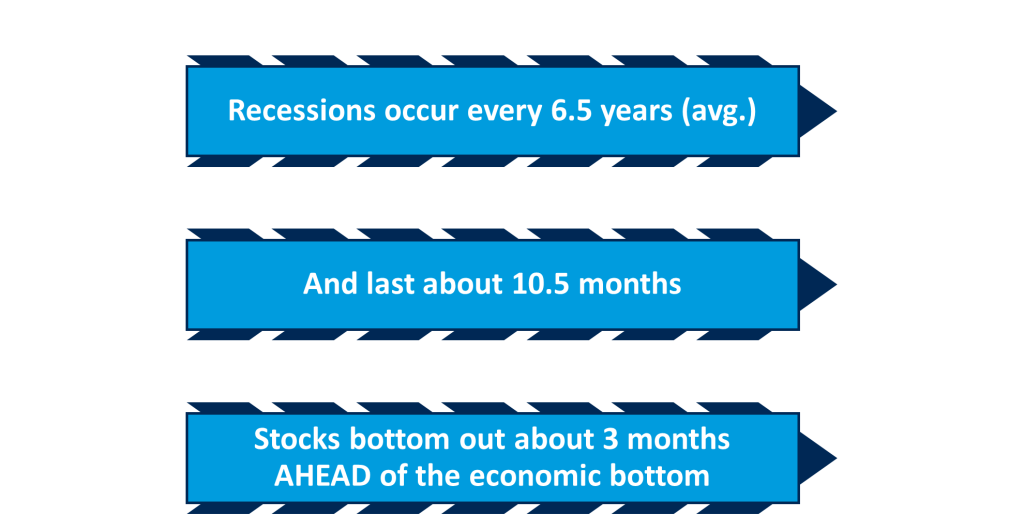For plan sponsors and their participants who follow the news, not a day passes without conflicting accounts concerning the markets and our economy. Headlines declare large layoffs at iconic companies, yet U.S. unemployment rates are at 50+ year lows. Inflation has moderated but families feel pinched, dampening consumer spending. Stocks had rallied on the hopes of a soft-landing, yet bank failures now generate an entirely new set of concerns. What is a sensible investor to do?
Fiducient Advisors strives to help clients achieve attractive returns, while mitigating risk. Important tenets of our approach include constructing thoughtfully created investment menus for defined contribution plans and broadly diversified portfolios for pension funds. In all instances, we discourage market timing. Given extreme uncertainty in both the markets and the economy, the need for diversification and patience may be as important as ever.
Investors ponder the risk of recession and how that might impact their portfolios. The debate among experts repeatedly focuses on whether we will experience a hard landing (recession) or a soft-landing (“Goldilocks” environment where inflation is tamed and recession avoided). This is the two-sided risk pundits argue and while these are legitimate concerns, we contend there is a third, less anticipated risk that should be on your radar. Below we present all three risks, debunk several myths, and share practical investment considerations.
Risk #1: Recession is likely, I’m nervous. If you are in this camp, it is helpful to recall that recessions are an ordinary part of the economic cycle. Since 1950, the U.S has experienced a recession roughly every 6.5 years, with the average recession lasting about 10.5 months.1
So how might your portfolio be impacted by a recession? On average, markets peak seven months prior to an economic downturn and bottom out three months before economic growth resumes.2 This means attempting to time the market can be a fool’s errand. Moreover, history has shown time is on the side of patient investors as broad markets have recovered to pre-recession levels following each and every pullback. For a diversified investor, the benefit becomes apparent when considering recovery times.
In advising long-term investors, we underscore the value of thoughtful diversification as well as the challenges of market timing by pointing out that the best days for equities actually occurred during bear markets or recessions. In fact, the 10 best days of percentage gains for the S&P 500 Index all took place during recessions.3

Source: Fiducient Advisors, The Bear Market Field Guide. June 30, 2022.
Risk #2: Soft-landing, we are good to go! If indeed the Fed can tame inflation without forcing the economy into a recession, and we resume solid economic growth, this should translate to good news for a variety of asset classes. Even though diversification is often considered a risk mitigation tool, it can play a role in capturing upside potential. Investors placing all their investment eggs in one basket may miss the rally.
Lower interest rates would make the “safe play” (cash) more penal for investors. Equities, particularly small cap stocks, and high-yield bonds could fare well. And long duration opportunities (think growth stocks, venture capital, private equity, etc.) may experience tailwinds too.
Risk #3: No recession, anemic growth. This less-contemplated environment creates a sideways setting where we never quite experience a recession but, because the economy avoids its “medicine”, we fail to achieve attractive economic growth levels for some time. Equity returns can be muted in this backdrop. However, fixed income may be relatively attractive and marketable alternatives (think hedge funds) could potentially shine.
Where does this leave us?
Whether we experience a recession or not, it is healthy to acknowledge that recessions are a regular part of our markets and economy. Because all three of the risks presented remain a possibility, investors would be wise to construct broad, thoughtfully diversified portfolios with the likelihood of at least some portion of their allocation performing well in any situation. This offers the prudent investor a fighting chance of achieving long-term goals, and that’s about as much as we can strive for in this challenging environment.
For additional details and to discuss how these risks may impact your portfolio, please reach out to any of the professionals at Fiducient Advisors.
1 Source: Fiducient Advisors – The Bear Market Field Guide, June 30, 2022
2 Source: Fiducient Advisors – The Bear Market Field Guide, June 30, 2022
3 Source: Wells Fargo, Bloomberg and Wells Fargo Investment Institute. Daily data 9.16.1991 – 9.15.2021 for SP 500 Index
Material Risks Disclosures
Fixed Income securities are subject to interest rate risks, the risk of default and liquidity risk. U.S. investors exposed to non-U.S. fixed income may also be subject to currency risk and fluctuations.
Cash may be subject to the loss of principal and over longer period of time may lose purchasing power due to inflation.
Domestic Equity can be volatile. The rise or fall in prices take place for a number of reasons including, but not limited to changes to underlying company conditions, sector or industry factors, or other macro events. These may happen quickly and unpredictably.
International Equity can be volatile. The rise or fall in prices take place for a number of reasons including, but not limited to changes to underlying company conditions, sector or industry impacts, or other macro events. These may happen quickly and unpredictably. International equity allocations may also be impact by currency and/or country specific risks which may result in lower liquidity in some markets.
Private Equity involves higher risk and is suitable only for sophisticated investors. Along with traditional equity market risks, private equity investments are also subject to higher fees, lower liquidity and the potential for leverage that may amplify volatility and/or the potential loss of capital.
Marketable Alternatives involves higher risk and is suitable only for sophisticated investors. Along with traditional market risks, marketable alternatives are also subject to higher fees, lower liquidity and the potential for leverage that may amplify volatility or the potential for loss of capital. Additionally, short selling involved certain risks including, but not limited to additional costs, and the potential for unlimited loss on certain short sale positions.
The information contained herein is confidential and the dissemination or distribution to any other person without the prior approval of Fiducient Advisors is strictly prohibited. Information has been obtained from sources believed to be reliable, though not independently verified. Any forecasts are hypothetical and represent future expectations and not actual return volatilities and correlations will differ from forecasts. This report does not represent a specific investment recommendation. The opinions and analysis expressed herein are based on Fiducient Advisor research and professional experience and are expressed as of the date of this report. Please consult with your advisor, attorney and accountant, as appropriate, regarding specific advice. Past performance does not indicate future performance and there is risk of loss.


